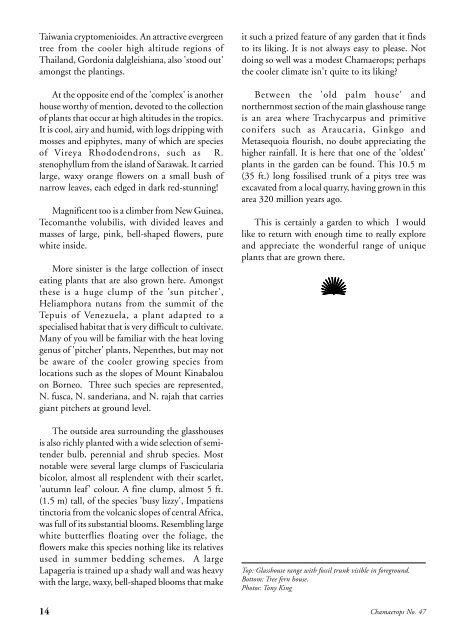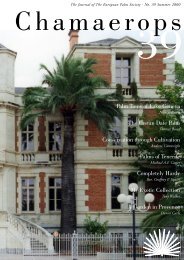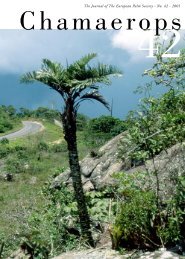Download - The European Palm Society
Download - The European Palm Society
Download - The European Palm Society
You also want an ePaper? Increase the reach of your titles
YUMPU automatically turns print PDFs into web optimized ePapers that Google loves.
Taiwania cryptomenioides. An attractive evergreentree from the cooler high altitude regions ofThailand, Gordonia dalgleishiana, also 'stood out'amongst the plantings.At the opposite end of the 'complex' is anotherhouse worthy of mention, devoted to the collectionof plants that occur at high altitudes in the tropics.It is cool, airy and humid, with logs dripping withmosses and epiphytes, many of which are speciesof Vireya Rhododendrons, such as R.stenophyllum from the island of Sarawak. It carriedlarge, waxy orange flowers on a small bush ofnarrow leaves, each edged in dark red-stunning!Magnificent too is a climber from New Guinea,Tecomanthe volubilis, with divided leaves andmasses of large, pink, bell-shaped flowers, purewhite inside.More sinister is the large collection of insecteating plants that are also grown here. Amongstthese is a huge clump of the 'sun pitcher',Heliamphora nutans from the summit of theTepuis of Venezuela, a plant adapted to aspecialised habitat that is very difficult to cultivate.Many of you will be familiar with the heat lovinggenus of 'pitcher' plants, Nepenthes, but may notbe aware of the cooler growing species fromlocations such as the slopes of Mount Kinabalouon Borneo. Three such species are represented,N. fusca, N. sanderiana, and N. rajah that carriesgiant pitchers at ground level.<strong>The</strong> outside area surrounding the glasshousesis also richly planted with a wide selection of semitenderbulb, perennial and shrub species. Mostnotable were several large clumps of Fasciculariabicolor, almost all resplendent with their scarlet,'autumn leaf' colour. A fine clump, almost 5 ft.(1.5 m) tall, of the species 'busy lizzy', Impatienstinctoria from the volcanic slopes of central Africa,was full of its substantial blooms. Resembling largewhite butterflies floating over the foliage, theflowers make this species nothing like its relativesused in summer bedding schemes. A largeLapageria is trained up a shady wall and was heavywith the large, waxy, bell-shaped blooms that makeit such a prized feature of any garden that it findsto its liking. It is not always easy to please. Notdoing so well was a modest Chamaerops; perhapsthe cooler climate isn't quite to its liking?Between the 'old palm house' andnorthernmost section of the main glasshouse rangeis an area where Trachycarpus and primitiveconifers such as Araucaria, Ginkgo andMetasequoia flourish, no doubt appreciating thehigher rainfall. It is here that one of the 'oldest'plants in the garden can be found. This 10.5 m(35 ft.) long fossilised trunk of a pitys tree wasexcavated from a local quarry, having grown in thisarea 320 million years ago.This is certainly a garden to which I wouldlike to return with enough time to really exploreand appreciate the wonderful range of uniqueplants that are grown there.Top: Glasshouse range with fossil trunk visible in foreground.Bottom: Tree fern house.Photos: Tony King14 Chamaerops No. 47










